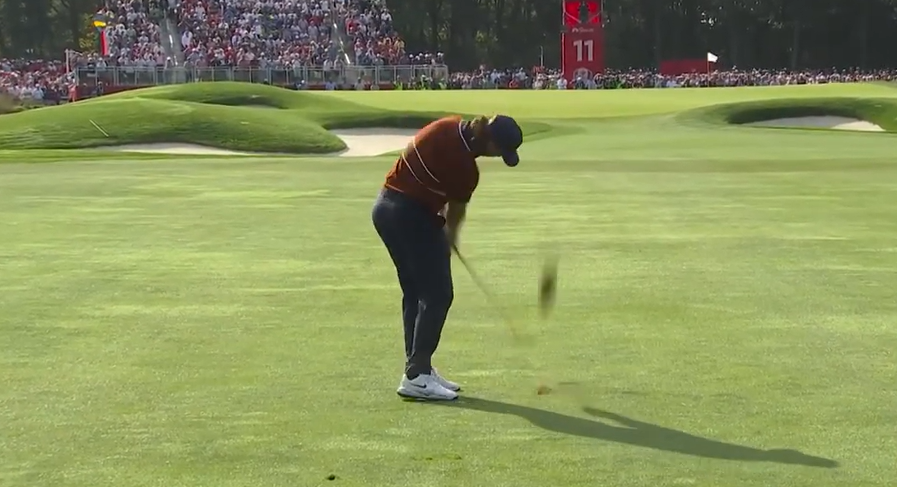The Ryder Cup is based on numbers that appear simple but have a dramatic feel to them. The first team to reach 14.5 points wins by a margin of victory, with 28 points up for grabs. The standard changes for the reigning champions, who can only hold onto 14 points. Numerous emotional narratives have been shaped by that half-point difference, sometimes changing legacies in ways that statistics alone could never explain.
This well-known calculation fuels excitement at Bethpage Black in 2025. After winning in Rome two years prior, Team Europe needs just 14 points to retain the trophy. But in order to regain it, Team USA needs to get to 14.5. This small margin turns into a powerful tool for creating drama, making every missed putt, every crucial birdie, and every match that is cut short have enormous meaning.
The structure resembles a strategic chessboard. Players compete in foursomes, fourballs, and singles matches over the course of three days, each of which results in precisely one point. Coworkers take turns shooting with a single ball in foursomes, which is a very flexible setup for demonstrating chemistry but also extremely punishing when coordination fails. Each golfer uses their own ball in fourballs, and the player with the lowest score on each hole wins. Ryder Cup history has frequently been shaped by Sunday’s singles, twelve head-to-head matches that have transformed unknown players into unexpected heroes.
Table: Ryder Cup Key Facts
| Category | Details |
|---|---|
| Tournament | Ryder Cup |
| Format | Match play (Foursomes, Fourballs, Singles) |
| Total Points Available | 28 |
| Points Needed to Win | 14.5 |
| Points Needed to Retain (Defending Champion) | 14 |
| Match Length | Maximum 18 holes |
| Established | 1927 |
| Current Champions | Team Europe (2023, Rome) |
| 2025 Venue | Bethpage Black Course, Farmingdale, New York |
| Reference | CNN – Ryder Cup Format Explained |

The dynamic is changed when half-points are awarded in tied games. The competition ended in an overall tie twice in history (1969 and 1989), with the incumbent keeping the trophy. A classic example of sportsmanship, Jack Nicklaus’s 1969 concession to Tony Jacklin is frequently reenacted as a reminder that morality can be just as important as winning. These half-points create a sense of suspense for fans, who use them to determine where the magic number is at any given time.
Think of Medinah in 2012, when Europe made a remarkable resurgence. They were behind 10–6 going into Sunday, but they won one after another to reach 14.5 points in what is now known as the Miracle of Medinah. The math appeared overwhelming, but perseverance, faith, and composure in the face of overwhelming pressure produced a victory that is still remembered today. The cultural impact of that comeback is still remarkably similar to that of other famous sports comebacks, like the New England Patriots’ rally in Super Bowl LI or Liverpool’s Champions League final in Istanbul in 2005.
The Ryder Cup’s team-based format in an individual sport is what sets it apart from other competitions. Players like Scottie Scheffler and Rory McIlroy need to incorporate their own rhythm into a larger plan. Captains act more like conductors than coaches, forming alliances that can either foster collaboration or, on occasion, fall apart under duress. While Keegan Bradley, taking over for Team USA, represents a noticeably new generational shift, Luke Donald, who will return to lead Europe in 2025, benefits from continuity.
The psychology of “how many points to win Ryder Cup” is just as fascinating as the math. Even though a two-foot putt on the 17th green is only worth half a point, millions of supporters’ lives could be on the line. Even the smallest detail has the power to become a pivotal moment. The Ryder Cup, according to Phil Mickelson, is “a pressure you cannot rehearse,” a feeling that arises directly from the chase to 14.5.
The way the Ryder Cup reflects society as a whole strikes a deeper chord. In contrast to majors, where individual skill is valued above all else, this competition demands participation from the entire roster. Even novices have a lot of responsibility, and their accomplishments have the power to change history. In the modern world, where teamwork is becoming more and more important for success in everything from politics to technology, that lesson seems especially helpful. Golf’s most individualistic venue turns into a showcase for collaboration, highlighting the fact that no superstar can achieve 14.5 by themselves.
Cross-cultural interactions intensify the resonance. In Rome, McIlroy’s altercations with American caddies sparked viral subplots that mirrored celebrity feuds more frequently found in music or movies. In this way, the Ryder Cup has evolved into a spectacle and sport hybrid, with dramatic flair in its numbers. Bethpage, which is renowned for its boisterous New York crowds, is expected to intensify that energy and make sure that the straightforward point-calculating process develops into something more than just a sport.
This contest’s volatility is further highlighted by history. Before Europe’s accession in 1979 evened the playing field, Team USA dominated for decades. Since then, even though the US frequently sends players with higher rankings, Europe has won 12 of the last 22 matches. This disparity demonstrates the chemistry, unity, and momentum’s extraordinarily potent ability to push toward the magic number. It is evidence that the Ryder Cup is a contest of team will rather than merely a ranking of the world’s best players.

